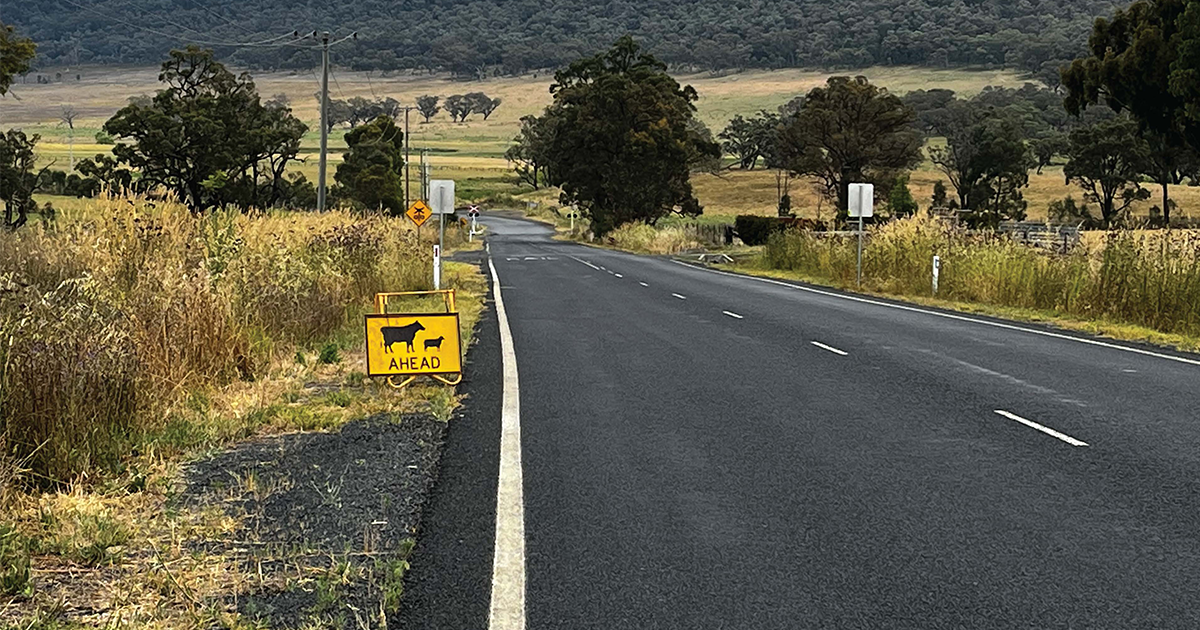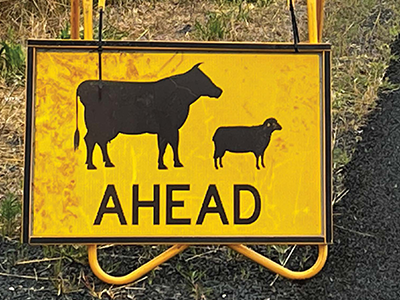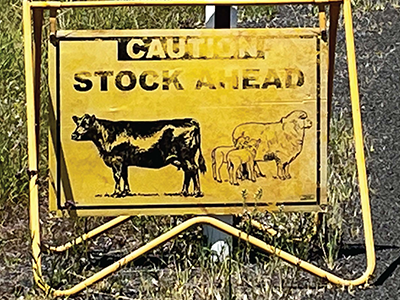Moving livestock on public roads
When it comes to moving or grazing livestock on public roads, both drovers and drivers have a responsibility to keep our roads safe.
Drovers and landholders who hold a stock permit authorising stock to be walked across or along a public road have the right to move livestock on public roads and are required to display signs so motorists are warned of the upcoming hazard.
There are several steps to take before moving or grazing livestock on public roads.

Do I need a permit?
Yes, unless an exception applies.
Before moving livestock along public roads, drovers and landholders are required to hold a stock permit from Local Land Services that authorises stock to be walked across or along a public road.
Stock permits may authorise a number of different things. Drovers and landholders need to check that the stock permit they hold expressly authorises stock to be walked across or along a public road.
Applications for permits should be made in advance and at least two working days before the permit is required.
Landholders with long term grazing permits for select travelling stock reserves must still obtain a separate permit to move or graze livestock on public roads.
Exceptions:
A stock permit is not required if any of the following applies and stock are travelling at the required travelling rate:
- the stock are horses that are being ridden or led in daylight
- the stock are drawing or being led by a vehicle in daylight
- the person is moving the stock in daylight from one part of a holding that is adjacent to another part of the holding from which it is separated only by a public road
- the person is moving the stock at any time along the road in an emergency
- the person is moving dairy cows from one part of a holding that is adjacent to another part of the holding from which it is separated only by a public road during the period between sunset and sunrise on the following day for the shortest practicable distance
- the person is authorised to walk or graze stock on the public road under any Act or regulation
- the stock are camels that are being ridden or led in daylight.
A stock zone must be in place
Before moving or grazing stock on or near a public road, drovers and landholders need to check that the area is a permanent stock zone, or set up a temporary stock zone.
Permanent stock zones are managed by Roads Authorities and are identified by a designated permanent stock zone sign.
Temporary stock zones may be established by a person who owns or has charge of stock grazing or walking on a public road. The person may set aside the whole or part of the road as a temporary stock zone by exhibiting a temporary stock zone sign at the entry point of the zone.
Signage requirements apply to temporary stock zones
Drovers and landholders must visibly display approved black and yellow warning signs to create a temporary stock zone.
Stock warning signs can be purchased from Local Land Services offices.
These signs must:
- meet the minimum size requirements of 900mm x 600mm and be in good condition
- be exhibited at the entry point of the zone to which it relates
- be clearly visible to motorists who approach stock in either direction
- when exhibited by an occupier of land through which an unfenced public road passes, be positioned so that a driver is warned at a reasonable distance of the presence or likely presence of stock
- when exhibited by a person who owns or has charge of stock that are grazing or walking on a public road, be positioned so that there are no more than five kilometres and no less than 200 metres between the sign and a place where a vehicle would encounter the stock.
The person must remove the temporary stock zone sign when the stock are no longer on or near the public road.
 |  |
| Example of a correctly displayed stock sign in good condition. | Example of an unacceptable stock zone sign. |
What are drovers’ responsibilities?
The owner or person in charge of stock on the public road must ensure, as far as practicable, that the stock do not pose a hazard to any person, animal or vehicle on the road.
If it is reasonably foreseeable that stock on or near a public road may be a hazard to any person animal or vehicle on the road, the owner or person in charge of the stock must ensure that the stock are in a stock zone.
Drovers in charge of travelling stock on a travelling stock reserve through which an unfenced public road passes must ensure, so far as is reasonably practicable, that the stock are fenced to prevent them from moving onto the public road between sunset and sunrise. This may require the drover to yard the stock in a temporary holding pen overnight. This will not apply to a person who has a stock permit which authorises the stock to enter, travel or graze on the public road.
To move stock on public roads, you must:
- obtain a stock permit from Local Land Services which authorises stock to be walked across or along a public road
- establish a temporary stock zone as outlined in this factsheet, or use a permanent stock zone
- keep stock under control and attended at all times
- have minimum $20 million Public Liability Insurance
- ensure stock meet National Livestock Identification System requirements
- comply with obligations under the Biosecurity Act 2015 and Biosecurity Regulation 2017.
Which stock permit do I need?
There are four classes of stock permits, as outlined under the Local Land Services Act 2013:
- walking stock permit
- grazing stock permit
- roadside grazing stock permit
- routine stock movement permit.
Walking stock permit
A walking permit may be used to walk stock from the owner's property to another property not owned by the stock owner.
Grazing stock permit
This is generally issued to the landholder adjoining an enclosed travelling stock reserve (TSR) for use over an extended period. It’s a condition of the permit that travelling stock are still permitted to access the TSR. A grazing permit is also issued for the use on an open TSR.
Roadside grazing stock permit
This type of permit is issued for a short period of time, over a specific section of road and usually in times of drought or for hazard reduction. It’s normally issued to the landholder adjoining the area as it may not have watering facilities. Therefore stock are moved back to the property at night. These permits are issued for shire roads.
Routine stock movement permit
This permit applies to routine movements of stock between two or more properties owned or occupied by the same person and are issued to local stock owners annually.
If you are moving livestock between one or more holdings, where you are not the owner/occupier, you must get consent from the owner. The landholder consent form is to be used in conjunction with the application form above.
For more information on Routine Stock Movement Permit applications, speak to your local customer service team today.
What are drivers’ responsibilities?
In a temporary stock zone, drivers must give way to stock and all other animals and any vehicle accompanying the stock. However, this does not mean that a person can leave stock unattended in a stock zone.
Unattended stock?
Fines apply to unattended stock on public roads. Landholders can be fined under the Public Spaces (Unattended Property) Act 2021 if stock are left unattended in public. On-the-spot fines, higher court penalties, rapid seizure action and enforcement orders for all offences are in force from 1 May 2023.
For more information
If you have any questions about moving livestock on public roads, contact your nearest Local Land Services office on 1300 795 299.